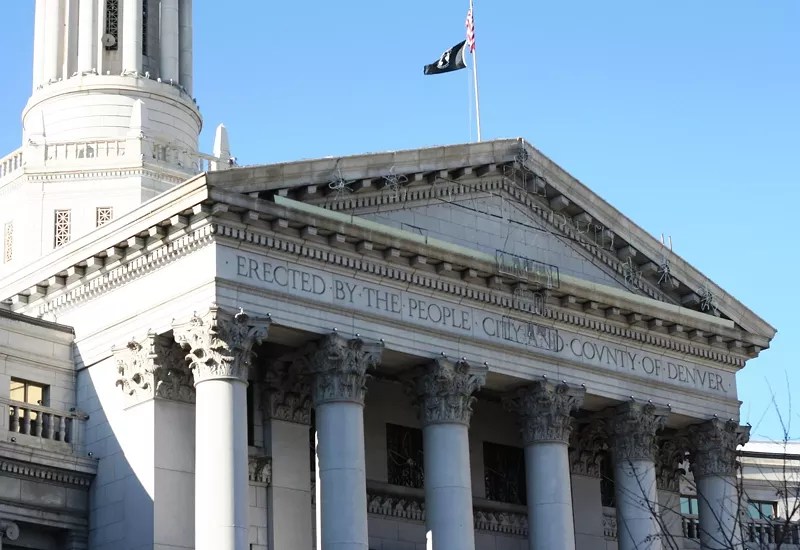
Flickr/OZinOH

Audio By Carbonatix
Imagine a mayor of Denver being sworn in after being elected with one-third of the vote or less. It’s happened more than once, though not in a very long time. These days, we elect Denver’s leaders by a majority of the vote. Well, almost all of them. We can close that loophole on November 4.
Question 2G on Denver’s ballot fixes a problem that has prevented Denver City Council’s two at-large members from being elected by a majority of the vote. Over the last nine elections, the average winning percentage of the at-large winners is just 28.6 percent. They have ranged between 16.6 and 38 percent; in two of those elections, the total of both winning candidates combined didn’t even reach 50 percent.
But by voting Yes on 2G, you can reverse a fluke court decision from more than fifty years ago that resulted in these two positions being the only ones elected by less – sometimes much less – than a majority. It does this by splitting the seats onto separate ballots, Seat A and Seat B, and lets candidates freely choose the seat for which they wish to compete. The voters then can confidently pick one for Seat A and one for Seat B, guaranteeing majority winners in both races every time.
Will you step up to support Westword this year?
At Westword, we’re small and scrappy — and we make the most of every dollar from our supporters. Right now, we’re $23,250 away from reaching our December 31 goal of $50,000. If you’ve ever learned something new, stayed informed, or felt more connected because of Westword, now’s the time to give back.
The current method forces all candidates onto a single ballot on which you can pick up to two, which has prevented any winner from getting a majority.
So how did we end up with this peculiar system? Here’s the background.
For many years, Denver elections were won by whoever got the most votes, no matter how few. For instance, Ben Stapleton was catapulted back into the mayor’s office in 1935 with only 33.3 percent of the vote, four years after he was ousted by a guy who got only 28 percent of the vote. Most of the Denver City Council members, too, were elected by much less than a majority. Some got less than 25 percent.
This was no way to elect the city’s leadership. So our runoff system was instituted in 1955, ensuring that all Denver mayors, city council members and the auditor were sworn in only after first having been chosen by a majority of the voters.
The current mismatch with the at-large seats came about when they were added to the council in 1971. These new seats were packaged with a planned switch to partisan municipal elections from our long tradition of nonpartisanship. The new system depended on holding Democratic and Republican precinct caucuses, district and citywide party assemblies, as well as party primary elections in May; the finalists faced off in a June general election.
However, one month before the start of the first precinct caucuses, the Colorado Supreme Court ruled in favor of a trio of Denver residents who sued the city over the partisan election change, and forced a return to nonpartisan elections. It pulled the rug out from under how at-large elections were supposed to be held.
Without party primaries to winnow down a large field of thirteen at-large hopefuls that first year, voters were forced to choose their top two from among everyone lumped on a single ballot. As you might expect, the top vote-getter that year won with less than 25 percent. The second seat went to someone who got less than 19 percent.
Question 2G gets back to the original intent of electing at-large members by a majority. Don’t let scary stories from skeptics fool you. Most cities with at-large members elect them in a fashion similar to 2G, and it works great. It’s much simpler, too. Every other race on the ballot is vote-for-one, so there’s less confusion than with the current method. It’s simpler – candidates pick the seat they want to run for, just like every other election.
It doesn’t invite big money into the race. That already happened in 2023, when the at-large race attracted more than a half million dollars in outside spending on both the winners and the losers. There’s nothing about 2G that brings more big money than would happen without it. Don’t be fooled by this silly argument.
And it doesn’t add costs. There have been fifteen citywide runoffs in the last eighteen elections, and most of them had increased voter turnout. It won’t cost another dime to tack an at-large runoff onto an already scheduled runoff. The at-large seats should be decided in the same way all other positions are elected, and 2G does that.
It’s simple: Officials who represent a citywide constituency should be elected by a citywide majority. That’s a basic principle of democracy, and it’s the driving motivation behind Referred Question 2G. Vote Yes by Nov. 4.